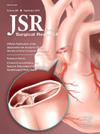Report Cards Are Out: Nine Years of Nonoperative Management for Blunt Abdominal Solid Organ Trauma
IF 1.8
3区 医学
Q2 SURGERY
引用次数: 0
Abstract
Introduction
There has been a dramatic shift toward nonoperative management (NOM) of blunt abdominal solid organ injuries (ASOIs) with angioembolization (AE). However, there is a lack of evidence assessing temporal trends in AE use, timing of intervention, and how these trends relate to NOM failure and patient outcomes over time. The aim of this study was to assess the trends in time to AE, its association with failure of NOM, and outcomes of these patients across the United States.
Materials and methods
We performed a retrospective analysis of the American College of Surgeons Trauma Quality Improvement Program database over 9 y, ending in 2021. We included adult patients (age ≥ 18 y) with blunt ASOI (spleen, liver, and kidney) who underwent AE within 4 h of hospital arrival. Patients who underwent operative intervention before AE were excluded. The primary outcome measured was the failure of NOM. Secondary outcomes included major complications, 24-h mortality, and in-hospital mortality. Multivariable regression analyses were performed to identify the independent effect of every hour delay in time to AE on outcomes.
Results
A total of 2203 patients with blunt ASOI who were managed nonoperatively with AE were identified. The mean age was 45, and 68% were male. On arrival, the mean systolic blood pressure was 105, and the median Glasgow coma scale was 15. The median Injury Severity Score and abdominal Abbreviated Injury Scale were 25 and 3, respectively. The median 4-h packed red blood cell, fresh frozen plasma, and platelet requirements were 2, 1, and 0, respectively. Overall, spleen was the most common angioembolized abdominal organ (57.3%), followed by the liver (28.9%) and kidney (13.8%). The median time to AE was 156 [114-195] min. Only 8% of patients underwent AE within the first 60 min of arrival. A significantly decreasing trend over the study period was observed in time to AE (2013:180 min versus 2021:105 min, P < 0.001). Among the study population, 19.7% experienced NOM failure, with a median [interquartile range] time to surgery of 5 [3-11] h. Over the years, there was a significant reduction in NOM failure rates (2013:26.2% versus 2021:8.7%, P < 0.001), major complications (2013:57.5% versus 2021:25.1%, P < 0.001), 24-h mortality (2013:6.8% versus 2021:1.3%, P = 0.006), and in-hospital mortality (2013:16.4% versus 2021:8.1%, P = 0.015). On multivariable regression analyses, every hour delay in time to AE was associated with higher odds of NOM failure (adjusted odds ratio [aOR]: 1.13, 95% confidence interval [CI] [1.02-1.16], P = 0.006), major complications (aOR: 1.12, 95% CI [1.02-1.23], P = 0.019), 24-h mortality (aOR: 1.19, 95% CI [1.09-1.52], P = 0.014), and in-hospital mortality (aOR: 1.17, 95% CI [1.01-1.35], P = 0.041).
Conclusions
NOM of patients with blunt ASOI has improved over the past 9 y, with failure rates decreasing by approximately 30%, indicating enhanced effectiveness of AE over time. Timely AE was independently associated with lower complication rates and reduced 24-h and in-hospital mortality, likely due to earlier hemorrhage control and mitigation of secondary physiologic decline. Efforts should focus on improving timely access to AE through standardized trauma protocols, early identification of candidates, and streamlined interventional radiology activation.
成绩单出来了:腹部钝性实体器官创伤的9年非手术治疗
钝性腹部实体器官损伤(asoi)的非手术治疗(NOM)和血管栓塞(AE)已经发生了巨大的转变。然而,缺乏证据评估AE使用的时间趋势、干预时间以及这些趋势与NOM失败和患者预后的关系。本研究的目的是评估AE的时间趋势,其与NOM失败的关系,以及美国这些患者的结局。材料和方法我们对美国外科学会创伤质量改善计划数据库进行了回顾性分析,时间跨度超过9年,截止到2021年。我们纳入了钝性ASOI(脾、肝、肾)的成年患者(年龄≥18岁),这些患者在入院后4小时内接受了AE。排除AE前接受手术干预的患者。测量的主要结局是NOM的失败。次要结局包括主要并发症、24小时死亡率和住院死亡率。进行多变量回归分析以确定每小时到达AE的时间延迟对结果的独立影响。结果2203例钝性ASOI患者均采用AE非手术治疗。平均年龄为45岁,68%为男性。到达时,平均收缩压为105,格拉斯哥昏迷评分中位数为15。损伤严重程度评分和腹部简略损伤量表的中位数分别为25分和3分。4小时红细胞、新鲜冷冻血浆和血小板需要量的中位数分别为2、1和0。总体而言,脾脏是最常见的血管栓塞腹部器官(57.3%),其次是肝脏(28.9%)和肾脏(13.8%)。发生AE的中位时间为156[114-195]分钟。只有8%的患者在到达后的前60分钟内发生AE。在研究期间,观察到AE的时间呈显著下降趋势(2013:180 min vs . 2021:105 min, P <;0.001)。在研究人群中,19.7%经历了NOM失败,手术时间的中位数[四分位数范围]为5[3-11]小时。多年来,NOM失败率显著降低(2013:26.2% vs . 2021:8.7%, P <;0.001),主要并发症(2013:57.5% vs 2021:25.1%, P <;0.001)、24小时死亡率(2013:6.8%对2021:1.3%,P = 0.006)和住院死亡率(2013:16.4%对2021:8.1%,P = 0.015)。在多变量回归分析中,每延迟1小时发生AE的时间与NOM失败(调整优势比[aOR]: 1.13, 95%可信区间[CI] [1.02-1.16], P = 0.006)、主要并发症(aOR: 1.12, 95% CI [1.02-1.23], P = 0.019)、24小时死亡率(aOR: 1.19, 95% CI [1.09-1.52], P = 0.014)和住院死亡率(aOR: 1.17, 95% CI [1.01-1.35], P = 0.041)相关。结论钝性ASOI患者的snom在过去9年中有所改善,失败率下降了约30%,表明AE的有效性随着时间的推移而增强。及时AE与较低的并发症发生率、24小时死亡率和住院死亡率独立相关,这可能是由于早期出血控制和减轻继发性生理衰退。努力的重点应该是通过标准化的创伤方案、早期识别候选者和简化介入放射激活来提高对AE的及时获取。
本文章由计算机程序翻译,如有差异,请以英文原文为准。
求助全文
约1分钟内获得全文
求助全文
来源期刊
CiteScore
3.90
自引率
4.50%
发文量
627
审稿时长
138 days
期刊介绍:
The Journal of Surgical Research: Clinical and Laboratory Investigation publishes original articles concerned with clinical and laboratory investigations relevant to surgical practice and teaching. The journal emphasizes reports of clinical investigations or fundamental research bearing directly on surgical management that will be of general interest to a broad range of surgeons and surgical researchers. The articles presented need not have been the products of surgeons or of surgical laboratories.
The Journal of Surgical Research also features review articles and special articles relating to educational, research, or social issues of interest to the academic surgical community.

 求助内容:
求助内容: 应助结果提醒方式:
应助结果提醒方式:


